I thought that the DNF at Marine Corps Marathon 50k was a minor disappointment. However, after I began dreaming about running another 50K and crossing the finish line, I knew that the mental impact was more profound than I realized. My subconscious continued to process how to move forward from an unachieved goal. So, instinctively, I knew that my first priority in 2025 would be to find and run a 50K. Although I didn’t feel down or upset consciously, I was aware of the deeper turmoil that was occurring by leaving this goal incomplete. If I left it unaddressed, I’d carry a mental anchor all year. I want to feel light, so the thought of carrying an anchor, even a mental one, was unwelcome.
On December 21, I found a local 50k trail race and registered without doing any research. My plan was to complete it and then share the accomplishment instead of “announcing” the goal. I’d never run on trails, but I thought it would be peaceful and less impactful on my body. Running on pavement for 31 miles is pretty jarring. Since it wouldn’t be an A or B race, minimizing the downtime from its impact was important.
After registering, I told Brandy, my coach, and she understood and was fully behind the effort. She added weight training and adjusted my triathlon training to emphasize running more. I didn’t have a finish time goal. The reason for racing this distance was more internal and awareness-focused. I wrote my goals as follows:
- Pay attention to how my body feels throughout the run and be aware of when my form begins to break down.
- Prepare for and confront the mental struggle of doubts and the desire to give up.
- Make sure to stay hydrated, but avoid drinking so much that it causes discomfort in my stomach.
- Take adequate carbs without overwhelming my stomach and getting nauseous or bonking. I’m guessing no more than 60g/hr
Pre-race prep
Huntsville State Park is just a short two-hour drive from my home, and I was looking forward to an early start, aiming to arrive by 6:30 a.m. However, my wife offered a fantastic suggestion—why not book a hotel room nearby and go a day early? This turned out to be a wise choice!
Organizing my gear was a breeze! With experience in three disciplines, I loved the simplicity of packing for this race. Being able to carry nearly everything from the start made it easier and allowed me to save mental energy! Also, if I were to forget something, it would be less impactful because the aid stations are full of various goodies. Also, the course looped past the start line, so I’d have an opportunity to go to my car if necessary. Finally, as I found out later while running, everyone out there wanted to help the runners. So, if I needed or even wanted something I didn’t have, all I had to do was ask, and it’s very likely someone would have it or know where to find it.
My full complement of gear:
- Nathan Pinnacle 12L hydration vest with a bladder (water only) + Nathan soft flask (water + LMNT electrolytes)
- Precision hydration collapsible bottle filled with 300g carbohydrates (Flow gel 300).
- 2 bottles of KetoneIQ w/ caffeine (one green apple, one peach)
- 5 packets of LMNT (random flavors, mostly raspberry)
- 1 Vespa 25 + 1 Vespa concentrate
- Atreyu Daily Trainer 1.2
- Varlo Praia triathlon shorts
- Bombas compression socks
- Hypervolt Plus
- Rapid Reboot compression boots + Jackery portable battery
- Igloo ice chest with two bottles of chocolate muscle milk and two beers.
Race Day
Since I was wise enough to listen to my wife and stay at a hotel near the park, I got plenty of sleep. My bags were packed. I got a 3 pm late checkout just in case I finished in time to return and shower. Then, I picked up some oatmeal and coffee from McDonald’s because I forgot to bring food from home. I had a reserved camping spot, but after locating it the night before, I realized it was useless because it wasn’t connected to the road leading to the start line. My plan was to have a place to prepare pre-race and then sit and relax post-race, but that wasn’t going to happen. Fortunately, I arrived early enough to snag a spot very close to the start/finish.
Uncharacteristically, I felt out of sorts as soon as I arrived. Everything was unfamiliar; I was alone and doing something completely new. Although I had my gear packed, I kept forgetting things. I walked and ran back and forth to my car multiple times. Finally, 10 minutes before we were scheduled to begin, Ben and I were walking to the start line, and I realized that I’d forgotten to fill my vest and bottle with water. I ran to my car to realize I didn’t bring any water. Fortunately, I’d filled my ice chest with ice the night before, and much of it was melted. So, I poured that water into my run vest’s bladder and had enough to fill the collapsible flask with the remaining water. I ran to the chute and joined Ben at the back of the line, still nervous and jittery. I was concerned that I’d released all my adrenaline before beginning the race.
3,2,1 Start
I kicked off the race alongside my buddy Ben, and it felt great to have his company as we settled into an easy pace. Neither of us was focused on winning; we were there to push our limits together! Being toward the back of the pack meant we walked more than we ran at first, which sparked a bit of nervous energy in me. However, I was eager to embrace the freedom of running and really enjoy the journey ahead. Together, we were ready to make the most of this experience!
Around the first street crossing, the pack of athletes was thin and I began running. Ben stayed behind and chatted with others, so I put in my earbuds, listened to my 50K playlist, and got my head in the game. The first aid station was 3.6 miles from the start (the 50K group did a slightly smaller first loop than the 50 miler racers). The time spent running from Ben to the aid station was mostly filled with focused self-awareness. I paid attention to how people approached and passed one another. Did they announce themselves, acknowledge one another as they passed, or slide by? I noticed that there was a lot of common gear among most of the athletes. Of course, most had running vests, and all the pockets were filled with things. Various bottles, wrappers, bags, and clothing accessories. The most common shoes were Altra and Hoka, which appeared to have built-in socks. The shoes looked like they didn’t have heels with the sock integrated into them. I couldn’t figure out how it worked or why someone would wear something like that.
The humidity was high, and although we began running at 7:30 am in early February, the temperature was almost 80 F. Being a profuse sweater, I made a mental note to keep the effort moderate and pay attention to my heat-fatigue. I was going to give myself the best chance at finishing this thing. As I approached the first aid station, I was surprised to see about 35 to 40 runners milling around and chatting casually. There didn’t seem to be any sense of urgency; it felt as if they were all simply on a training run. My immediate instinct was to pass by all of these runners and improve my ranking. However, I recognized that my ego was surfacing, so I took a moment to relax and remind myself that this race was not about speed or beating anyone else. I came here to challenge myself. Additionally, I realized that I was inexperienced, and perhaps these runners had knowledge that I lacked. After all, we had only completed 4 of the 31 miles. It was better to be patient and observe the experienced runners instead.So, I decided to stop, fill my bladder and collapsible bottle. To my surprise, the aid station offered a wide variety of foods: pickles, oranges, bananas, pretzels, gummy bears, freshly made bacon, peanut butter and jelly sandwiches, ramen noodles, and an assortment of sugary, caffeinated drinks.
Even though everyone around me was friendly and smiling, I really craved some time to myself to reflect. I exchanged warm greetings and then happily headed back onto the trail. My shirt was thoroughly soaked, but oddly enough, it didn’t bother me at all! As I immersed myself in my 50K playlist, I zoned out, momentarily forgetting to keep an eye on the trail. I occasionally kicked exposed roots and stumbled, feeling determined to stay upright despite the challenges. This little dance with the trail lasted for at least 13 miles. My toes and feet were definitely feeling the strain, which was a clear sign that I should have opted for proper trail shoes instead of my usual road running shoes. The softness in the front of my shoes was no match for the rugged terrain, leaving my toes to endure quite a bit of discomfort. I was more concerned about puncturing my shoes or possibly breaking a toe than falling. While stumbling was a little frustrating, it reminded me to stay alert and engaged with my surroundings. This experience opened my eyes to how music influences my runs. While it can be an incredible source of motivation, it also pulls me away from being fully present.
Aid station two was similar to the first, except it was less crowded, and I needed to refill my water bladder. Also, I’d gotten very hungry, so I ate half of a peanut butter and jelly sandwich, pretzels, some orange wedges, pickle slices, and half a banana before setting off. I took mental stock as I left ( approximately 9 miles in) and felt great. My legs showed no signs of fatigue; I was still running upright, and my shoulders were relaxed. I wasn’t watching my pace, so I didn’t know how fast I was running. I was making progress, and my head was clear.
Reaching the next aid station was such an exhilarating milestone, representing both the starting line and halfway point of the race! Hitting the 16-mile mark ignited a wave of excitement and confidence within me for the amazing day ahead. Instead of rushing through the aid station, like in a triathlon, I embraced this moment, taking the time to thoughtfully refuel my body. The aid stations, nestled in the woods created a delightful atmosphere to recharge and truly enjoy the event. I felt invigorated and eager to take on the next leg of the race with joy and unwavering determination! Let’s keep pushing!
The Pain Train
The stretch between the halfway point and the next aid station at mile 20 turned out to be one of the most challenging segments of the race. By mile 17, I began feeling mild cramping in my calf muscles, prompting me to pause and stretch them occasionally. Initially, this brought some relief, but around mile 19, I faced a new hurdle: cramping in my anterior tibialis every time I tried to stretch my calves. This unfortunate cycle led to further instability; whenever I focused on alleviating the tension in my tibialis, my calves would cramp dramatically. The discomfort escalated, and soon, both the inner and outer sides of my lower legs were cramping so intensely that flexing my feet while running became a considerable challenge. They would lock into rigid positions, making navigation over uneven terrain increasingly precarious.
Instead of forcing myself to keep running. I stopped and massaged the muscles in hopes that they’d relax. They were already tender to the touch but did respond to some acupressure and slow massaging. I could walk without much cramping, but as soon as I attempted to pick up the pace, my feet and legs would lock up. So, I decided to enjoy the scenery and accept the situation as it was. I’m running a 50K trail race. I didn’t train on trails, wear the proper shoes, or bring any excuses for stopping. Just put one foot in front of the other and keep going however you can. At one point, I sat at a picnic table and really dug into my legs. It was painful, but I thought it would help them relax. I probably sat there rubbing for 15 minutes, watching other runners pass. Most of them asked if I was ok or if I needed anything. I replied with my appreciation and shared that I was fine, just working out some leg cramps.
Something happened around mile 20; the cramping eased up enough to allow me to power walk and slowly run without inducing the cramping. So, I did just that for the next 7 miles. During that time, I tried to continue copying other runners by walking the inclines, avoiding the sections with excessively exposed tree roots, and walking off-trail to avoid the super muddy sections. I also celebrated reaching 26.2 miles. That was my first trail marathon, and I still felt strong. Surprisingly strong, actually. I remember thinking I didn’t feel much physical fatigue; my hip flexors were beginning to tire. Other than the cramping, I was good to go. I said, damn, I have built a really good base of fitness, and I’m stronger than I thought. After an hour or two of feeling down about the inability to run much, that was uplifting.
As I paused for a well-deserved break at the last aid station around mile 25, I found a comfortable log to sit on and took a moment to massage my legs. It was the perfect opportunity to recharge and savor the delightful food spread before me. There were delicious sandwiches, crunchy pickles, an abundance of fresh orange wedges, and an interesting selection of ramen that was warm and salty—definitely a unique flavor experience! I also enjoyed chatting with the friendly volunteers, which added a positive touch to my rest stop. After refilling my water bottle, I felt ready and invigorated to tackle the final stretch of the race.
To my surprise, I was able to run even more vigorously. I remained cautious because one of the volunteers mentioned that there were only five more miles to go, but it would feel like seven. I knew that time would slow down during the final stretch of the race. Then, someone from the 50-mile race said that his watch’s GPS was inaccurate. He claimed that although the aid station was at 27 miles, his watch indicated he was at mile 33. This left me feeling both cautious and excited about what the last five miles would bring.I chose to compete in this distance to confront my mental demons and prove to myself that they are not telling the truth. My best weapon against doubt and uncertainty is the proof I gain by pushing through and exceeding my perceived limits. Until this point in the race, I hadn’t encountered any negative self-talk, so I expected it to arise during the final section. I was determined to push myself and see if I could provoke doubt amidst the pain and fatigue. I was ready for the challenge and eager for the battle.
I ran-walked most of the last section, going back and forth with four other athletes. I would pass someone, then someone else would pass me, then I’d walk, and one of the previous runners came past me again. we did that for a long time, and it was nice to see familiar faces repeatedly. The distraction of the other runners was welcome, too, because I couldn’t figure out where I was. Although I repeated the same loop a second time, it felt unfamiliar. As expected, I became excited when I reached what I believed to be within 2 miles of the finish line. However, I was wrong whenever I thought I knew what was around the next turn or over a hill. Then the 50 miler’s comments came back to haunt me: maybe my watch’s GPS is off, and I’m more than 2 miles from finishing.
I had hit a wall. My legs were now aching badly, and my feet were heavy. The happiness had dissipated, and all I wanted was to be finished. Then, at mile 29/30, Ariel texted me asking how I was doing. I replied fine. He said, let’s pick up the pace and finish this thing strong. That pissed me off, and I replied, “Stop.” Then about 10 steps later I admitted that he was right, if I still felt strong (although in pain), there was no reason I shouldn’t finish strong. I picked up the pace and focused on running the remainder of the race. As I came around the final curve and entered the finisher’s chute, I was overcome with relief and filled with joy. I’d completed my goal and defeated the mental demons this time.
Crossing the finish line after 8 hours and 48 minutes was exhilarating! Although my feet and toes were quite sore and my fingers felt a bit swollen, the sense of accomplishment made it all worthwhile.
Lessons
- I ambitiously entered my first trail race as a 50K. After finishing, several seasoned runners told me this course is not ideal for beginners; it is quite technical.
- I found that consuming 60 grams of carbohydrates or less while running works well for me. I didn’t experience any gastrointestinal discomfort. Additionally, I didn’t have to be overly strict with my intake; I took sips of the gel approximately every 15 to 20 minutes and never felt a dip in energy. This was a significant discovery for me.
- I found that taking small sips of water every 10 to 15 minutes worked well for me during the race. I did not experience a sloshy stomach or become dehydrated. By the end of the race, my urine was a more golden yellow, which indicated some dehydration. However, I felt fine for the entire 30 miles.
- Hunger comes in waves and doesn’t take much to satisfy it.
- Wear the appropriate shoes for the event. This is a lesson I keep learning. Shoes are quite expensive these days, and I hesitated to buy a good pair of trail shoes for just one event. I wasn’t sure if I would enjoy trail running or want to do it again, so I decided against purchasing any. Unfortunately, my feet, ankles, and leg muscles suffered because of that choice.
- I have a remarkably good base of fitness for a 54-year-old. This makes me happy and optimistic about the future.
- Even when I intentionally start an event to learn, explore, and be relaxed, my inner competitive spirit unexpectedly emerges.
- The trail running community stands out for its remarkable warmth, inclusiveness, and unwavering support for all members.
- You can harness your inner strength to endure pain and rise above it. By tapping into this power, you can diminish the impact of the pain and emerge even stronger.
- Although my goal was to complete the race and confront an internal struggle, finishing in over 8 hours left me feeling a mix of joy and embarrassment. I believe that 8 hours is too long. However, I am grateful for how aware and thoughtful I remained throughout the experience. I learned to slow down and navigate through difficult moments, which I take pride in. Both of these perspectives on my race coexist within me.
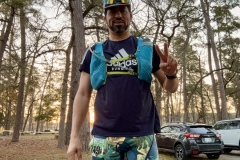
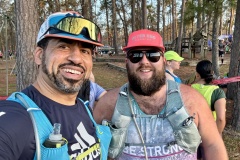
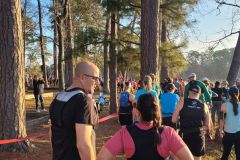
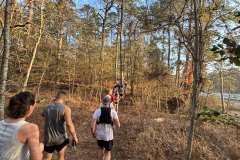
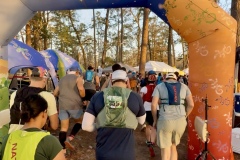

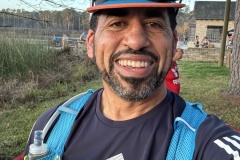
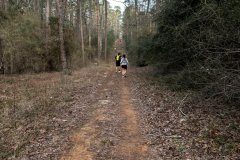
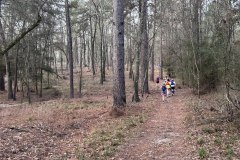
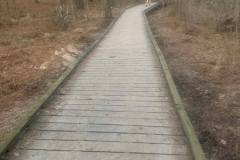
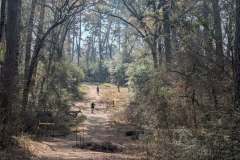
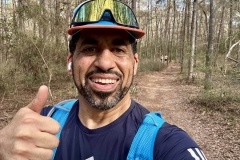

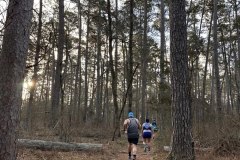
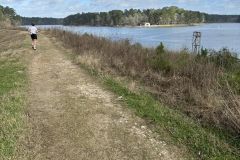

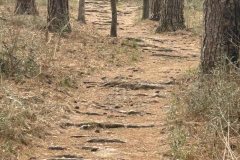
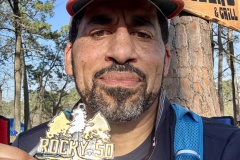
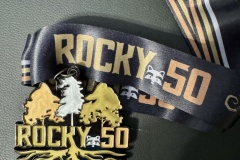




Awesome story of perseverance and redemption, along with a heaping dose of badass grit.